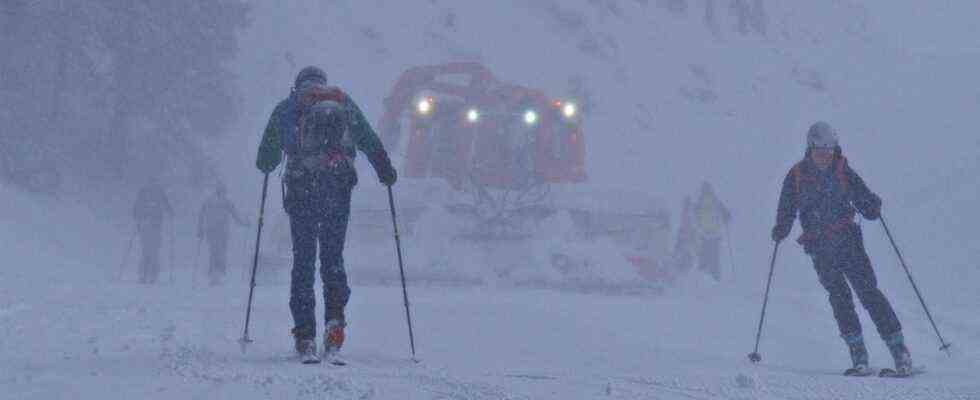Bavaria’s winter holiday resorts are starting the second pandemic winter with a great handicap: The strictest corona regulations in the German-speaking Alpine region are causing the cable car operators from Berchtesgaden to Oberstdorf to fear for their existence. Prime Minister Markus Söder (CSU) and his state government have stipulated “2G Plus” for leisure facilities: If you want to ride a gondola or lift, you not only have to be vaccinated and / or recovered, but also present a current corona test. The Association of German Cable Cars has already complained about an impending “fatal blow”.
In Austria, on the other hand, only 2G is required, an additional test is not necessary. The Swiss ski resorts have the advantage. There are similar rules for the cable cars as for buses and trains: mask compulsory only in closed rooms including gondolas, 3G (vaccinated, recovered or tested) or 2G are not necessary. Chair lifts and drag lifts may be used without a mask. That does not mean that optimism has broken out in Switzerland. Uncertainty reigns everywhere. “Unfortunately, we cannot make any forecasts, as the new situation with the Omicron virus cannot yet be assessed,” says a spokeswoman for Switzerland Tourism. Since Friday, Germany has also classified the Confederation as a high-risk area due to the increasing number of infections, as did Austria before – bad news for the hotel industry in both neighboring countries. However, the Swiss winter sports resorts had already survived the first Corona winter 2020/2021 with the slightest losses. There are currently many indications that this could repeat itself in a similar form.
The lockdown didn’t end until the spring
At the Bavarian cable cars, the number of paying guests in regular operation shrank to zero last season, as the lockdown did not end until spring. In some places the railways only ran for a few ski races. Since the duration of the closings at the beginning of last winter could not be foreseen, the slopes in Garmisch-Partenkirchen and elsewhere were diligently groomed and the gondolas and lifts kept operational. However, the slopes were used almost exclusively by non-paying ski tourers who climbed the mountains in droves with muscle power.
In Austria last season, the foreign guests, who make up the majority of the winter vacationers, were largely absent. Before the pandemic, the Austrian cable cars counted over 50 million “skiing days” per season. According to data from the Austrian Chamber of Commerce, there were still 9.2 million in 2020/21. As in the Bavarian winter sports resorts, the number of guests fell by more than 90 percent in the middle of winter. It looked similarly bleak for the tourism industry in South Tyrol. The Swiss hotel industry, on the other hand, reported 9.4 million overnight stays for the 2020/2021 winter season, a comparatively small minus of 26.4 percent for Corona conditions.
And at least the start of this year’s season is positive from a Swiss point of view: “We are currently recording a very good booking situation compared to last year,” says Jan Steiner from Engadin PR in St. Moritz. “There are currently no restrictions or closings, our season got off to a great start, thanks in part to the early snowfall in November.” This is also thanks to the snow-sure location: the high valley is at over 1700 meters. In Austria and South Tyrol, ski resorts and winter holiday resorts can hope, at least with some justification, that this season will be better than the previous one. However, no one expects the return to the usual number of guests: At the moment, no serious forecast is possible, says Franz Hörl, chairman of the cable car industry in the Austrian Chamber of Commerce. “However, it is already clear to us that it will not be a season like it used to be before Covid-19, because restrictions are to be expected.”
Any hope of recovery dies
In Bavaria, on the other hand, there is desperation among the ski resort operators. “With these resolutions, any hope of recovery in the winter sports industry dies,” commented cable car association chief Matthias Stauch on the 2-G-Plus rule. The German ski areas suffer from a natural competitive disadvantage anyway: Since the Bavarian mountains cannot compete in height and size with the high mountain regions of the neighboring countries, the ski areas are also smaller and the season shorter. The mountain stations in most Bavarian areas are lower than the valley stations in St. Moritz. Many of the smaller Bavarian ski areas only take their guests to the modest heights with chair lifts and drag lifts. One example is the Spitzingsee, one of the most popular excursion destinations in Upper Bavaria. There are no gondolas in the ski area. Skiers, cross-country skiers, winter hikers and tobogganers alike find themselves in the fresh air. However, according to the current status, stricter regulations will apply to guests than, for example, in Bavarian local transport.

